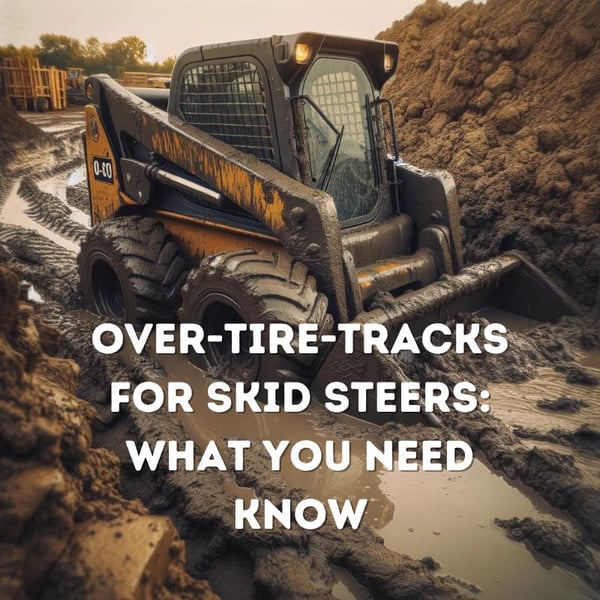Skid steer loaders are versatile workhorses in numerous industries ranging from heavy construction to delicate landscaping. These compact machines are renowned for their maneuverability and ability to tackle various tasks. One crucial aspect of skid steer loaders is their choice of wheel tracks. Sometimes, tires won't do the job when you need more flotation or traction, and that's where over-the-tire tracks come in. When selecting the right OTT tracks for your skid steer loader, understanding the pros and cons of each option is vital.

In this Shop Talk Blog post, we'll look at the pros and cons of rubber and steel over tire tracks.
Here are some additional Shop Talk Blog posts you might find helpful:
Rubber Over Tire Tracks
Rubber OTTs are a great solution for situations where your skid steer needs more flotation, or you need to better distribute the ground pressure from your machine. Here are some pros and cons of rubber over the tire tracks.
Pros of Rubber OTT Tracks
So, what are the benefits of using rubber over-the-tire tracks instead of wheels? Let's take a look ...
- Enhanced Traction: Rubber tracks offer excellent traction on terrains like mud, snow, deep sand, and uneven surfaces. This traction is especially critical when it's critical that you maintain the control and stability of your skid steer.
- Low Ground Pressure: Rubber tracks distribute the weight of the SSL over a larger surface area, leading to lower ground pressure and greater flotation. This feature makes rubber tracks suitable for delicate surfaces like lawns, gardens, and finished landscapes, minimizing the risk of damage. Rubber OTTs perform best when looking for minimal ground disturbance and maximum flotation on surfaces like turf, sand, and snow.
- Reduced Vibrations: Rubber tracks absorb shock and vibration better than other track types, meaning a smoother ride for the operator and reduced wear and tear on the machine.
Cons of Rubber OTT Tracks
There are some drawbacks to rubber over-the-tire tracks for skid steers. Here are the main two:
- Higher Cost: Rubber tracks typically have a higher initial cost than steel tracks. While the initial investment may be higher, reduced ground damage and operator comfort benefits may justify the expense for certain applications.
- Limited Durability: While modern rubber tracks are designed to be durable, they may not withstand abrasive surfaces and sharp debris, including rocks and sharp-edged stones, as well as their steel counterparts. Frequent use on rough terrain or construction sites can lead to quicker wear and tear of your tracks, necessitating more frequent replacements.
Steel Over Tire Tracks
Steel OTT tracks can handle some of the roughest, harshest working conditions your skid steer loader can face. Let's look at the pros and cons that come with them.
Pros of Steel OTT
Here are the pros of steel over the tire tracks:
- Increased Stability: Steel tracks' weight and rigidity enhance stability and traction, especially when navigating steep slopes or carrying heavy loads. This stability is crucial for maintaining control and safety during the more challenging tasks you're undertaking with your skid steer loader.
- Performance in Extreme Conditions: Steel OTT improves your skid steer loader’s performance in extreme conditions, such as from muddy surfaces, rocks, and ice. You'll see them used in industries such as recycling plants, demolition, land clearing, and forestry.
- Exceptional Durability: Steel tracks are known for their durability and resistance to wear, making them ideal for heavy-duty applications and abrasive surfaces (such as rocky terrain and construction sites). They can withstand prolonged use in harsh conditions without the type of damage you'd see with rubber tires or rubber OTT.
- Longevity: Steel tracks generally have a longer lifespan than rubber tracks, which reduces the frequency of replacements and maintenance costs over time. This longevity can result in cost savings for operators in industries with demanding work environments.
Cons of Steel OTT Tracks
Now let's look at the cons of steel over the tire tracks:
- Higher Ground Pressure: Steel tracks are going to exert more concentrated pressure than rubber tracks, increasing the risk of damaging delicate surfaces like lawns and pavements. Operators need to exercise caution when operating skid steer loaders with steel tracks in this type of environment.
- Greater Vibrations and Shock: Steel tracks transmit more vibrations to the operator and the machine than rubber tracks. This can lead to increased operator fatigue during extended periods of operation and may require additional measures to mitigate discomfort.
Conclusion
In conclusion, the choice between rubber and steel OTT tracks for skid steer loaders depends on various factors, including the intended application, terrain conditions, and budget considerations. While rubber tracks offer lower ground pressure, reduced vibrations, and enhanced traction, steel tracks excel in durability, longevity, and stability. Operators must weigh these pros and cons carefully to select the most suitable wheel tracks for their specific needs, ensuring optimal performance and efficiency in their operations.


